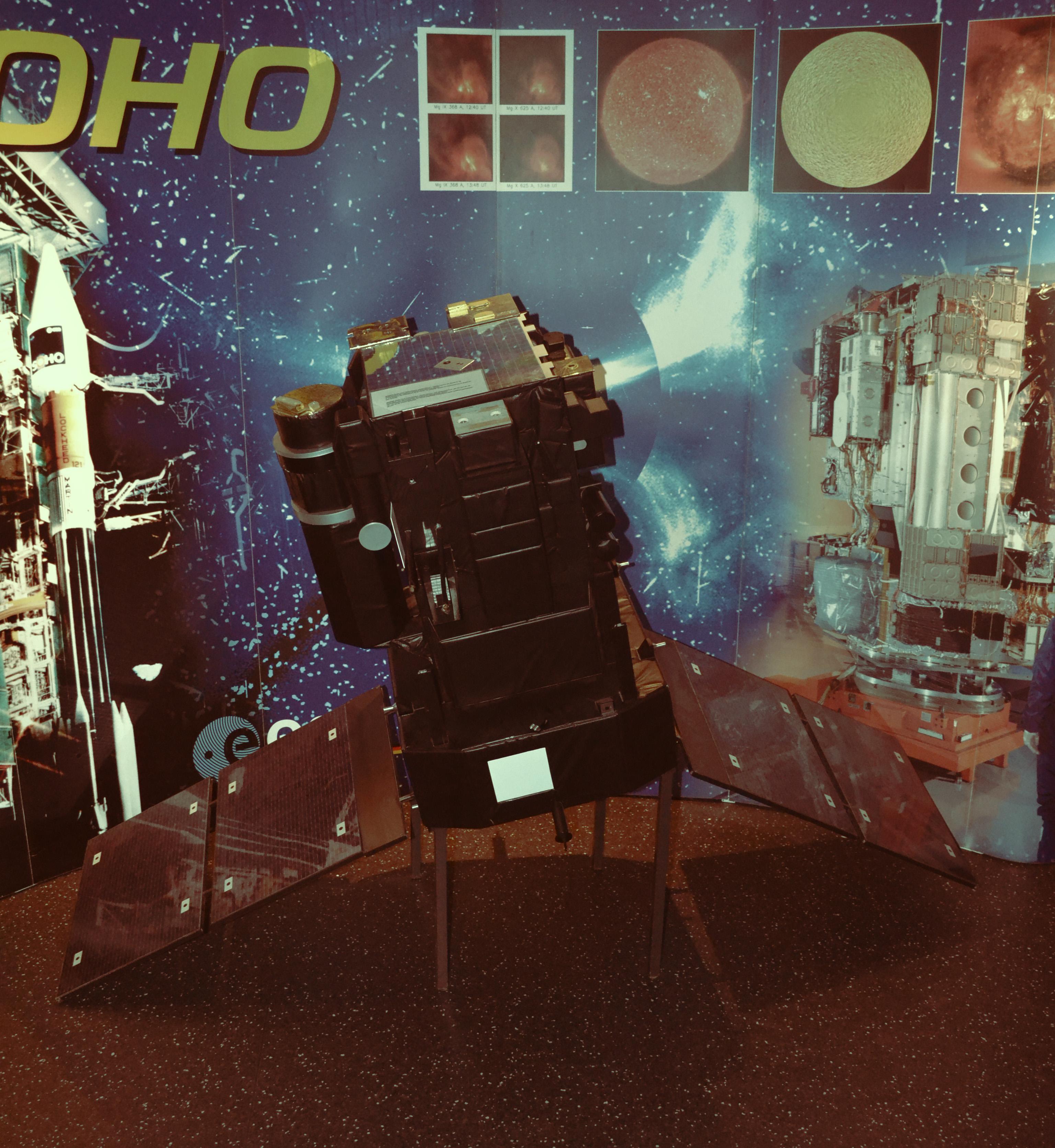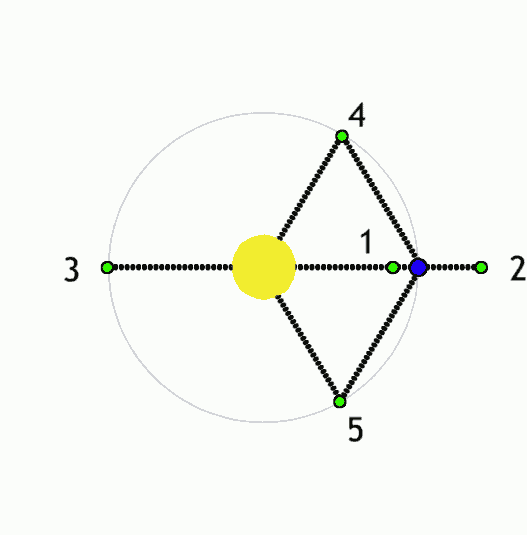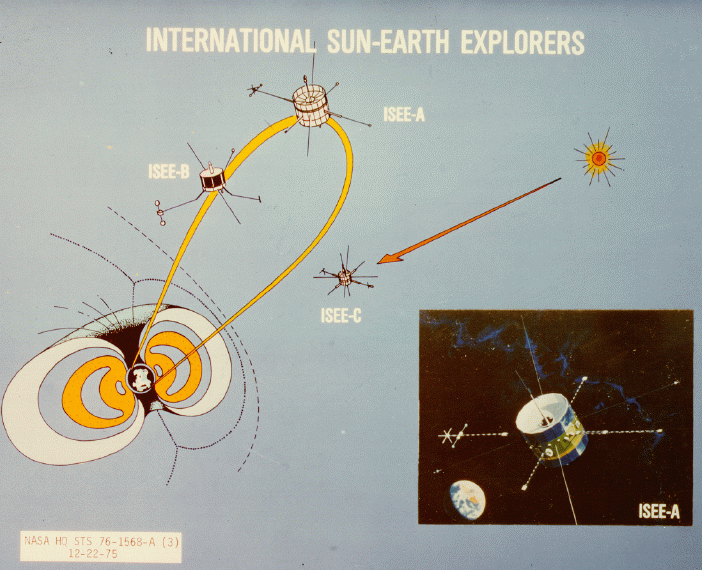|
Halo Orbit
A halo orbit is a periodic, non-planar orbit associated with one of the L1, L2 or L3 Lagrange points in the three-body problem of orbital mechanics. Although a Lagrange point is just a point in empty space, its peculiar characteristic is that it can be orbited by a Lissajous orbit or by a halo orbit. These can be thought of as resulting from an interaction between the gravitational pull of the two planetary bodies and the Coriolis and centrifugal force on a spacecraft. Halo orbits exist in any three-body system, e.g., a Sun–Earth–orbiting satellite system or an Earth–Moon–orbiting satellite system. Continuous "families" of both northern and southern halo orbits exist at each Lagrange point. Because halo orbits tend to be unstable, station-keeping using thrusters may be required to keep a satellite on the orbit. Most satellites in halo orbit serve scientific purposes, for example space telescopes. Definition and history Robert W. Farquhar first used the name " ... [...More Info...] [...Related Items...] OR: [Wikipedia] [Google] [Baidu] [Amazon] |
Solar And Heliospheric Observatory
The Solar and Heliospheric Observatory (SOHO) is a European Space Agency (ESA) spacecraft built by a European industrial consortium led by Matra Marconi Space (now Airbus Defence and Space) that was launched on a Lockheed Martin Atlas IIAS launch vehicle on 2 December 1995, to study the Sun. It has also discovered more than 5,000 comets. It began normal operations in May 1996. It is a joint project between the European Space Agency (ESA) and NASA. SOHO was part of the International Solar Terrestrial Physics Program (ISTP). Originally planned as a two-year mission, SOHO continues to operate after 29 years in space; the mission has been extended until the end of 2025, subject to review and confirmation by ESA's Science Programme Committee. In addition to its scientific mission, it is a main source of near-real-time solar data for space weather prediction. Along with Aditya-L1, Wind, Advanced Composition Explorer (ACE), and Deep Space Climate Observatory (DSCOVR), SOHO is one ... [...More Info...] [...Related Items...] OR: [Wikipedia] [Google] [Baidu] [Amazon] |
NASA
The National Aeronautics and Space Administration (NASA ) is an independent agencies of the United States government, independent agency of the federal government of the United States, US federal government responsible for the United States's civil list of government space agencies, space program, aeronautics research and outer space, space research. National Aeronautics and Space Act, Established in 1958, it succeeded the National Advisory Committee for Aeronautics (NACA) to give the American space development effort a distinct civilian orientation, emphasizing peaceful applications in space science. It has since led most of America's space exploration programs, including Project Mercury, Project Gemini, the 1968–1972 Apollo program missions, the Skylab space station, and the Space Shuttle. Currently, NASA supports the International Space Station (ISS) along with the Commercial Crew Program and oversees the development of the Orion (spacecraft), Orion spacecraft and the Sp ... [...More Info...] [...Related Items...] OR: [Wikipedia] [Google] [Baidu] [Amazon] |
ISRO
The Indian Space Research Organisation (ISRO ) is India's national space agency, headquartered in Bengaluru, Karnataka. It serves as the principal research and development arm of the Department of Space (DoS), overseen by the Prime Minister of India, with the Chairman of ISRO also serving as the chief executive of the DoS. It is primarily responsible for space-based operations, space exploration, international space cooperation and the development of related technologies. The agency maintains a constellation of imaging, communications and remote sensing satellites. It operates the GAGAN and IRNSS satellite navigation systems. It has sent three missions to the Moon and one mission to Mars. Formerly known as the Indian National Committee for Space Research (INCOSPAR), ISRO was set up in 1962 by the Government of India on the recommendation of scientist Vikram Sarabhai. It was renamed as ISRO in 1969 and was subsumed into the Department of Atomic Energy (DAE). The establi ... [...More Info...] [...Related Items...] OR: [Wikipedia] [Google] [Baidu] [Amazon] |
Euclid (spacecraft)
''Euclid'' is a wide-angle space telescope with a 600-megapixel camera to record visible light, a near-infrared spectrometer, and photometer, to determine the redshift of detected galaxies. It was developed by the European Space Agency (ESA) and the Euclid Consortium and was launched on 1 July 2023 from Cape Canaveral in Florida. The mission is named after the ancient Greek mathematician Euclid. After approximately one month, it reached its destination, a halo orbit around the Sun-Earth second Lagrange point L2, at an average distance of 1.5million kilometres beyond Earth's orbit. There the telescope is to remain operational for at least six years. The objective of the ''Euclid'' mission is to better understand dark energy and dark matter by accurately measuring the accelerating expansion of the universe. The Korsch-type telescope will measure the shapes of galaxies at varying distances from Earth and investigate the relationship between distance and redshift. ''Euclid'' i ... [...More Info...] [...Related Items...] OR: [Wikipedia] [Google] [Baidu] [Amazon] |
The New York Times
''The New York Times'' (''NYT'') is an American daily newspaper based in New York City. ''The New York Times'' covers domestic, national, and international news, and publishes opinion pieces, investigative reports, and reviews. As one of the longest-running newspapers in the United States, the ''Times'' serves as one of the country's Newspaper of record, newspapers of record. , ''The New York Times'' had 9.13 million total and 8.83 million online subscribers, both by significant margins the List of newspapers in the United States, highest numbers for any newspaper in the United States; the total also included 296,330 print subscribers, making the ''Times'' the second-largest newspaper by print circulation in the United States, following ''The Wall Street Journal'', also based in New York City. ''The New York Times'' is published by the New York Times Company; since 1896, the company has been chaired by the Ochs-Sulzberger family, whose current chairman and the paper's publ ... [...More Info...] [...Related Items...] OR: [Wikipedia] [Google] [Baidu] [Amazon] |
James Webb Space Telescope
The James Webb Space Telescope (JWST) is a space telescope designed to conduct infrared astronomy. As the largest telescope in space, it is equipped with high-resolution and high-sensitivity instruments, allowing it to view objects too old, List of the most distant astronomical objects, distant, or faint for the Hubble Space Telescope. This enables investigations across many fields of astronomy and cosmology, such as observation of the Population III star, first stars and the Galaxy formation and evolution, formation of the first galaxies, and detailed atmospheric characterization of potentially habitable exoplanets. Although the Webb's mirror diameter is 2.7 times larger than that of the Hubble Space Telescope, it produces images of comparable optical resolution, resolution because it observes in the longer-wavelength infrared spectrum. The longer the wavelength of the spectrum, the larger the information-gathering surface required (mirrors in the infrared spectrum or antenna a ... [...More Info...] [...Related Items...] OR: [Wikipedia] [Google] [Baidu] [Amazon] |
Von Kármán (lunar Crater)
Von Kármán is a large lunar impact crater that is located in the southern hemisphere on the far side of the Moon. The crater is about in diameter and lies within an immense impact crater known as the South Pole–Aitken basin of roughly in diameter and deep. Von Kármán is the site of the first soft-landing on the lunar far side by the Chinese Chang'e 4 spacecraft on 3 January 2019. Name The crater is named after Hungarian-American aeronautical engineer Theodore von Kármán. Overview The northern third of this formation is overlain by the rim and outer rampart of the walled plain Leibnitz, forming a deep indentation in the formation. The remainder of the outer wall is roughly circular in shape, although it is irregular and heavily worn by subsequent impacts. The interior of Von Kármán has been subjected to flooding by lava flows after the original crater formed, leaving the southern portion of the floor nearly flat. This surface has a lower albedo than the surroun ... [...More Info...] [...Related Items...] OR: [Wikipedia] [Google] [Baidu] [Amazon] |
Chang'e 4
Chang'e 4 (; ) is a robotic spacecraft mission in the Chinese Lunar Exploration Program of the CNSA. It made a soft landing on the far side of the Moon, the first spacecraft to do so, on 3 January 2019. A communication relay satellite, , was first launched to a halo orbit near the Earth–Moon L2 point in May 2018. The robotic lander and '' Yutu-2'' () rover were launched on 7 December 2018 and entered lunar orbit on 12 December 2018, before landing on the Moon's far side. On 15 January it was announced that seeds had sprouted in the lunar lander's biological experiment, the first plants to sprout on the Moon. The mission is the follow-up to Chang'e 3, the first Chinese landing on the Moon. The spacecraft was originally built as a backup for Chang'e 3 and became available after Chang'e 3 landed successfully in 2013. The configuration of Chang'e 4 was adjusted to meet new scientific and performance objectives. Like its predecessors, the mission is named after Chang'e, ... [...More Info...] [...Related Items...] OR: [Wikipedia] [Google] [Baidu] [Amazon] |
Queqiao Relay Satellite
''Queqiao'' relay satellite (), is the first of the pair of communications relay and radio astronomy satellites for the Chinese Lunar Exploration Program. The China National Space Administration (CNSA) launched the Queqiao relay satellite on 20 May 2018 to a halo orbit around the Earth–Moon L2 Lagrangian point Queqiao is the first communication relay and radio astronomy satellite at this location. The name ''Queqiao'' ("Magpie Bridge") was inspired by and came from the Chinese tale ''The Cowherd and the Weaver Girl''. Design and development Queqiao was designed to function as a communication relay for the Chang'e 4 mission to the far side of the Moon, as well as a deep space radio astronomy observatory for the Chinese space program. Direct communication with Earth is impossible on the far side of the Moon, since transmissions are blocked by the Moon. Communications must go through a communications relay satellite, which is placed at a location that has a clear view of both ... [...More Info...] [...Related Items...] OR: [Wikipedia] [Google] [Baidu] [Amazon] |
Gaia (spacecraft)
''Gaia'' was a space observatory of the European Space Agency (ESA) that was launched in 2013 and operated until March 2025. The spacecraft was designed for astrometry: measuring the positions, distances and motions of stars with unprecedented precision, and the positions of exoplanets by measuring attributes about the stars they orbit such as their apparent magnitude and color. , the mission data processing continues, aiming to construct the largest and most precise 3D space catalog ever made, totalling approximately 1 billion astronomical objects, mainly stars, but also planets, comets, asteroids and quasars, among others. To study the precise position and motion of its target objects, the spacecraft monitored each of them about 70 times over the five years of the nominal mission (2014–2019), and about as many during its extension. Due to its detectors not degrading as fast as initially expected, the mission was given an extension. As of March 2023, the spacecraft had en ... [...More Info...] [...Related Items...] OR: [Wikipedia] [Google] [Baidu] [Amazon] |
European Space Agency
The European Space Agency (ESA) is a 23-member International organization, international organization devoted to space exploration. With its headquarters in Paris and a staff of around 2,547 people globally as of 2023, ESA was founded in 1975 in the context of European integration. Its 2025 annual budget was €7.7 billion. The ESA Human and Robotic Exploration programme includes human spaceflight (mainly through participation in the International Space Station programme); as well as the launch and operation of missions to Mars and Moon. Further activities include science missions to Jupiter, Mercury, the Sun, Earth observation, Asteroid impact avoidance and Telecommunications missions, designing launch vehicles; and maintaining Europe's Spaceport, the Guiana Space Centre at Kourou (French Guiana). Further programmes include space safety, satellite navigation, applications and commercialisation. The main European launch vehicle Ariane 6 is operated through Arianespace ... [...More Info...] [...Related Items...] OR: [Wikipedia] [Google] [Baidu] [Amazon] |
International Cometary Explorer
The International Cometary Explorer (ICE) spacecraft, designed and launched as the International Sun-Earth Explorer-3 (ISEE-3) satellite, was launched on 12 August 1978 into a heliocentric orbit. It was one of three spacecraft, along with the mother/daughter pair of ISEE-1 and ISEE-2, built for the International Sun-Earth Explorer (ISEE) program, a joint effort by NASA and ESRO/ ESA to study the interaction between the Earth's magnetic field and the solar wind. ISEE-3 was the first spacecraft to be placed in a halo orbit at the Earth-Sun Lagrange point. Renamed ICE, it became the first spacecraft to visit a comet, passing through the plasma tail of comet Giacobini-Zinner within about of the nucleus on 11 September 1985. NASA suspended routine contact with ISEE-3 in 1997 and made brief status checks in 1999 and 2008. On 29 May 2014, two-way communication with the spacecraft was reestablished by the ISEE-3 Reboot Project, an unofficial group, with support from the Skyco ... [...More Info...] [...Related Items...] OR: [Wikipedia] [Google] [Baidu] [Amazon] |





